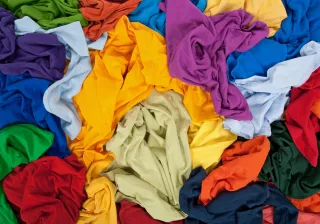Where did the materials of a garment come from? Where was it made, what chemicals were used in the production process? How should I care for it to make it last longer? Is the product environmentally friendly? How do I recycle the garment when it’s at the end of its life cycle? People have many questions about garments. The information that’s available is sparse and often incomplete.
Image: Elina Onkinen, Aalto ARTS

Challenge competition brought together experts from different organisations
In autumn 2020, we participated in the Circular Design Challenge Competition. Together with VTT, Aalto University, the Natural Resources Institute Finland (Luke) and the Finnish Environment Institute (SYKE), we created a concept that promotes transparency in the textile value chain. The idea was presented to companies and other stakeholders at the Circular Fair event.
Why transparency is important
Most textiles are manufactured from non-renewable synthetic materials and in 2019, these accounted for 63%. In recent years, there has also been a lot of talk about the origin of textiles and the working conditions in textile production.
The EU Waste Framework Directive coming into effect in 2025 requires separate collection of used textiles. Finland has a goal of starting the collection already in two years' time, in 2023. We need new sustainable materials and innovative solutions for utilising recycled materials. To enable sustainable textile consumption in a circular economy, consumers need more information to support their purchase decisions: What is the entire textile value chain like? Is it responsible? Is the garment recyclable, environmentally friendly and sustainable? How big its carbon footprint?
Having access to more information would increase consumer confidence and interest
We asked a thousand Finnish consumers aged 20 to 65 what kind of information they need about a garment to support their purchase decisions and how they would like to access that information.
Slightly more than half (54%) of the respondents felt that there is currently enough information available, but the other half (46%) wanted more information on the entire life cycle of a garment to support their purchase decision and to guide the use, maintenance and recycling of the garment. In particular, consumers want information on the quality and durability of garments (91%), instructions for use and care (68%), materials used in the garments (69%) and chemicals used in the production process (55%). Of course, the comfort (94%), appearance (86%) and price (90%) of the garments were factors affecting the purchase decision.
As a rule, the respondents relied on the information on the garment's care tag (80%), even though it is of course fairly limited. The role of shop staff is also important in getting reliable information (66%). In addition, consumers look for information on the internet, either on the brand's home page (58%) or the vendor's website (56%). Information received from advertisements, social media or discussion forums was not considered very reliable. Transparency was something that consumers definitely wanted to see improved.
Smartphone as a natural part of information retrieval
Consumers thought (74%) that having access to additional information on a garment, having transparency in the value chain, would increase their interest and trust in a brand. The majority of consumers (68%) would be interested in using their smartphones for retrieving information. Naturally, young people (76%) were more prepared to use their phones.
Consumers felt that using their phone to retrieve information would be the easiest and fastest way. It would also be the natural choice since people always have their phones with them. On the other hand, not everyone was comfortable with the idea of using their phone, especially when shopping.
During the challenge competition, we outlined a concept of adding a QR code to a garment's care tag, providing consumers more information about the garment in a reliable way and in one place. This information would help consumers to not only make purchase decisions, but also throughout the life cycle of the garment. This comprehensive solution would also help consumers make increasingly sustainable choices in their textile consumption habits.





